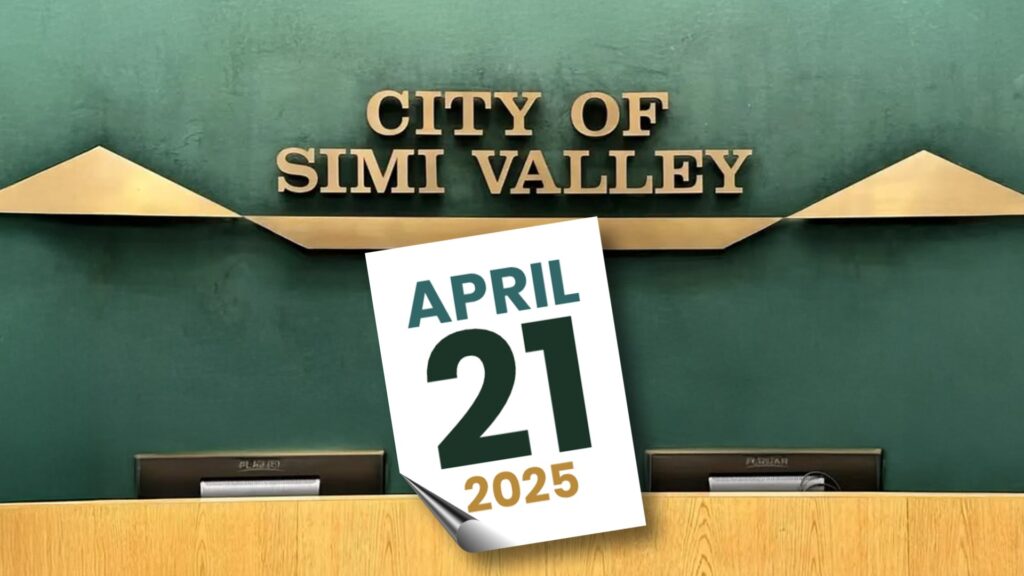
(CLAIR | Simi Valley, CA) — The April 21, 2025, Simi Valley City Council meeting tackled some of the city’s most pressing challenges—ranging from police staffing shortages and city employee pay gaps to youth leadership, public safety, and emergency preparedness. In a packed agenda that reflected both the city’s growing pains and its community spirit, council members heard passionate reports from city staff, union leaders, and residents. They approved new infrastructure funding tools, celebrated teen-led cultural events, and honored volunteers ready to respond in a crisis. From economic concerns to environmental awareness, the meeting showed a city at a crossroads—facing serious issues with open dialogue and practical steps forward.
Police Department Staffing Crisis Reaches Tipping Point
At the April 21 meeting of the Simi Valley City Council, Police Commander Bryan Samples delivered a sobering update on staffing levels within the Simi Valley Police Department. The department is currently authorized to employ 124 sworn officers. However, only 105 officers are actively on duty. Several others are out due to injury, and six are actively seeking employment with other agencies. This significant shortfall is now impacting essential police operations. Commander Samples announced that the department’s Investigations Unit would lose approximately 720 hours of work this summer due to staffing constraints. Additionally, the city’s entire special enforcement team—which handles gang activity, illegal firearms, and parole checks—is being temporarily pulled from the field. Samples warned the council that without immediate salary adjustments to remain competitive with neighboring cities, the department risks further officer departures, which could diminish public safety and response capabilities in the community.
Citywide Pay Gaps Fuel Retention Struggles
Carson Acosta, representing SEIU Local 721, spoke to the council about serious concerns related to employee compensation across city departments. He shared data showing that more than 30 percent of municipal job classifications in Simi Valley begin at under $25 per hour. In comparison to similar positions in nearby cities like Thousand Oaks and Ventura, Simi Valley pays as much as 46 percent less. Acosta and other union members presented this as a major factor in the city’s growing recruitment and retention problem. Employees shared personal experiences of burnout and being forced to leave jobs they loved for better-paying opportunities elsewhere. The council acknowledged that these pay disparities have led to higher turnover, frequent vacancies, and mounting training costs. As a first step toward addressing the issue, a citywide salary survey is being proposed for inclusion in the next budget cycle. That survey would assess market competitiveness and could form the basis for future pay structure reforms.
Council Approves Joining SCIP Infrastructure Program
In a unanimous vote, the city council approved joining the Statewide Community Infrastructure Program, known as SCIP. This initiative allows developers to finance public infrastructure improvements—such as roads, sewer lines, and parks—through tax-exempt bonds issued by the California Statewide Communities Development Authority (CSCDA). Under the SCIP structure, property owners voluntarily assume the cost of improvements, and Simi Valley retains full control over which projects qualify and move forward. City officials described the move as a strategic step to encourage economic development and remove financial barriers for builders. The decision introduces a powerful new tool for funding key projects without dipping into the city’s general fund or raising local taxes.
Youth Council Celebrates Cultural and Creative Success
Santa Susana High School freshman Lakshmi Julakanti, a representative of the Simi Valley Youth Council, presented an inspiring report on recent youth-led events. She highlighted two successful initiatives. The first was a two-night talent show held at the Cultural Arts Center, which featured performances by over 20 local students and drew more than 150 attendees. The second event was a multicultural fair, hosted at Santa Susana High School, which celebrated the diversity of Simi Valley and welcomed over 200 residents. The fair included 15 cultural booths representing traditions from around the world. Julakanti also noted that the Youth Council recently created a public service announcement on substance abuse prevention, which was shared during the talent show. In addition, they have launched new wellness-focused programs to help teens manage academic stress. These events not only showcase the leadership and creativity of local youth but also strengthen the city’s commitment to inclusion and mental health support.
2-1-1 System Serves as Critical Safety Net
Eric Sternad, executive director of Interface Children & Family Services, delivered an update on the 2-1-1 information and referral system. He reported that in 2024, over 2,100 residents in Simi Valley called 2-1-1 for assistance. Across Ventura County, the system handled more than 58,000 total contacts. Most inquiries were for housing and emergency aid, although 2-1-1 also supports disaster response, transportation planning, and hate crime reporting. The service connects users with more than 2,000 vetted health and human services across the region. Sternad emphasized that 2-1-1 is more than just a crisis line—it’s a critical infrastructure that ensures people in need are connected to the right help, especially during times of widespread emergency like the Mountain Fire. The program is available 24/7 and operates in partnership with dozens of counties across California.
City Updates Legislative Platform on Sober Living Homes
Deputy City Manager Heather Sumagaysay presented the latest updates to the city’s legislative platform, including new priorities aimed at addressing growing concerns about the regulation of sober living homes. Sumagaysay explained that while these homes play an essential role in helping people recover from addiction, current state laws make it difficult for cities like Simi Valley to enforce local standards or limit their concentration in residential neighborhoods. The updated platform supports advocacy for reforms that would give cities more oversight while still preserving housing rights for those in recovery. The council expressed strong interest in continuing this dialogue and influencing upcoming state legislation in a way that balances neighborhood stability with the needs of vulnerable populations.
Economic Concerns Prompt Call for Regional Vigilance
Mayor Pro Tem Mike Judge raised alarms about larger economic and demographic trends impacting Simi Valley and Ventura County as a whole. He referenced declining population numbers and shrinking revenue bases as growing threats to the region’s long-term stability. Of particular concern was pending state legislation such as AB 1421, which could further limit local authority over land use and housing policy. Judge urged the council to monitor these developments closely and to work proactively with other jurisdictions to protect Simi Valley’s interests. His comments echoed broader concerns being voiced across the county about rising costs, outmigration, and policy shifts that may put added pressure on local governments.
Transit Users Frustrated by Inadequate Signage
Council Member Elaine Litster spoke on the challenges riders face using Simi Valley Transit due to poor signage and unclear route information. She described hearing from new riders, particularly seniors and those with limited mobility, who found it difficult to navigate the city’s bus system. While the transit service itself is reliable, signage at many bus stops lacks critical details such as route maps, estimated arrival times, or directional arrows. The council expressed interest in reviewing this issue further and working with the Public Works Department to explore signage upgrades and digital wayfinding tools. Improving public transit accessibility is seen as a key part of the city’s long-term sustainability and equity goals.
CERT Program Adds 22 New Emergency Responders
The city recognized the graduation of 22 new members of the Community Emergency Response Team (CERT), a volunteer program that trains residents in basic disaster response techniques. Since its inception, over 1,600 Simi Valley residents have completed CERT training, which includes first aid, fire safety, light search and rescue, and coordination with emergency services. CERT plays a critical role during natural disasters and other large-scale emergencies, providing trained support to first responders and helping to organize neighborhood-level assistance. The new graduates were honored in a brief ceremony and thanked for their commitment to keeping Simi Valley resilient and ready.
City Proclaims Earth Day and Earthquake Preparedness Month
Finally, the council issued proclamations declaring April as Earthquake Preparedness Month and April 22 as Earth Day. These proclamations were presented alongside brief remarks about the importance of community education and environmental stewardship. Earthquake Preparedness Month will feature city-sponsored workshops and digital outreach campaigns encouraging families to update emergency kits and create household plans. Earth Day events, co-sponsored by local schools and park agencies, will include community cleanups and educational booths on conservation. These recognitions reflect Simi Valley’s broader efforts to promote civic awareness, environmental responsibility, and proactive public safety planning.














